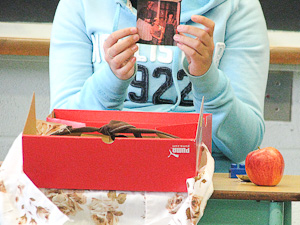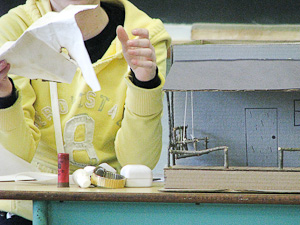This week I was finally able to watch the Student Success Grades 7 & 8 Differentiated Instruction DVD. This DVD chronicles 6 school regions from across Ontario. There are snippets of differentiated classrooms that have been videotaped for the purpose of showing DIA in action across the province. It was very interesting to watch these classes and compare them to my own this year. I would say, that I feel like I am getting more and more comfortable utilizing DIA every week. This video stresses the need to continue to work with each student at his / her own point of readiness to learn. I have also been finding some clips on YouTube that deal with DIA.
http://www.youtube.com/watch?v=FJMkcL6Do0Q
http://www.youtube.com/watch?v=jPUfj4MSQQU
http://www.youtube.com/watch?v=oS45ZkIh_rA
The last clip specifically deals with an English teacher, so I found that to be quite interesting. The teacher, in this video, connects with her students in an energetic way. If you listen to the comments the students are making it is very clear that the teaching style allows for student self examination and higher level thinking. The “loyalty line” is an activity that I would definitely consider trying when I get to our Merchant of Venice study in a few weeks.
Tuesday, Oct. 20 I was at the Board Office to meet with fellow Learning Classroom teachers. We shared how our demonstration lessons have been going so far. Discussion also centered around the questions that have been coming up in all of our debriefing sessions. It was good to know that we all have similar concerns. We had some time to transfer our lesson plans to the Ministry template; we talked about professional reading goals; and we had some technology PD involving Smart Boards. We also were allowed to select some professional reading books on which we will report back in the new year.
On Wednesday, Oct. 21 the EESS DIA Professional Reading Group met at lunch to go over the first 2 chapters of Carol Ann Tomlinson’s The Differentiated Learner. We just barely began to get into the book during our lunch meeting. However the dialogue was refreshing and it encourages me to know that others at EESS are eager to try to new approaches in their learning and the learning of their students. We discussed why “creating a classroom community” is vital to the success of DIA and what areas we may begin to start differentiating. We also talked about reflecting upon our teaching practice more (despite the fact that most of us have little time to do so).
Strategies Used This Week
Monday (Oct. 19) and Wednesday (Oct. 21) my students presented their time capsule projects. They were required to pick one character from To Kill a Mockingbird (they had the choice of any character—no one was off limits here). They needed to create a time capsule that would reflect the character and include 8 objects which would describe the character somehow. They also needed to select 5 important quotations from the text about their characters. Again, each student was being assessed on their presentation skills and their ability to reveal a character’s importance to the novel (but the differentiation component was giving the students choice in character selection and freedom to be creative).
Below are some pictures of those time capsules and of students in mid-presentation.

Dill Harris' Time Capsule (with the lamp post, letter, pictures and the Coke bottle which Dolphus Raymond shows Dill at the trial)

Calpurnia's Time Capsule (complete with pictures, an apron and an apple)

Judge Taylor's Time Capsule (here a student shows shoe polish the Judge would use to shine his shoes)

Boo Radley's Time Capsule (the roof lifts off to reveal the contents inside)

A Group of Time Capsules -- notice the brief cases and the jewelery boxes
Also on Monday (Oct. 19), in ENG 4U1, I had my students do a word web for The Great Gatsby. Each group was given the same series of words and the students had to arrange those words to somehow reflect key concepts about their reading (and understanding) of the novel. It is always amazing to me how students can interpret similar material differently. This exercise was all about giving the class choice: in selecting the words to use, in deciding how to lay out the words on the chart paper, in the proximity of the words and in the use of colour and graphics on the paper. Some examples of these word webs are below.

Sample #1 of Word Web for Gatsby-- ENG 4U1

Sample #2 of Word Web for Gatsby-- ENG 4U1
Tuesday (Oct. 20) my 2D1 students took their unit test on the novel. Over the last 3 years I have started to view testing differently from when I first started teaching. I want to give my students ample opportunity to show what they know on a test. As a result of this, my tests usually include many graphic organizers (since students are accustomed to working with these in class) and many chances to “get it right”. By having students fill out charts, make connections etc. this takes away the “one right answer” approach that a lot of tests require. Students (on my tests) are able to draw from what they have learned in class and expand that knowledge onto their test paper. A test should not be a trick or a regurgitation of facts (and it should most definitely not test material that students have never encountered before). Of course, I want my students to make connections and be able to think critically about concepts discussed in class. That is why this type of test allows them to use their higher level thinking skills. They are given a prompt and then they must make sense of it based upon what we have discussed and what they have learned.
During the test, I left up the Big Idea wall at the back of the classroom. The purpose for this was to show students that the ideas that we put up on the wall were not being tested. Instead, the purpose of the test was to take those ideas and use them to reflect upon what they have learned. Since I was at PD on the day of the test, I specifically asked my supply teacher to tell me how many students utilized the Big Idea wall. She noted that out of 25 students only 10 got up to check the Big Ideas. That was what I expected– not everyone would need to use the Big Ideas, but it was nice just to know they were available as a handy reference.
Wednesday – Friday (Oct. 21- 23) students worked on their To Kill a Mockingbird essays in class. I wanted to give them 3 class periods so that I could monitor their progress and check their writing status. Each student was given a Learning Contract for this assignment. Essentially, this is a contract between the student and the teacher which requires the student to complete certain tasks before handing in his/her work. I wanted to try this approach to see if it would allow for more students to hand in their assignments on the actual due date (and to see if students would stay more focused on the task at hand). At each step of completion (i.e. complete the graphic organizer, write your 3 point thesis) the student needs to show me the finished task. I would then stamp this as completed on their Learning Contract and he / she could more onto the next task on the contract. This may seem like a lot of work for the teacher – and yes, it can be—but sometimes we need to invest of ourselves if we expect our students to do the same.
Exit Card comments from students this week about activities in class:
- “I thought the time capsule was a good way for us to figure out more things about characters. The learning contract does help me stay on track and make sure I get everything done. It will definitely help me make sure I’m done by Wednesday.”
- “The learning contract is effective. I want you to keep doing this because it adds structure and helps me get my work done at a proper pace and not procrastinate until the last day or two.”
- “I really like the work periods you gave us for our Mockingbird essay. I do not like doing homework so it’s good so I can get it done in class. Also the test was good. I like the format of graphic organizers and that we could use the Big Ideas. I like the learning contract because it makes our essay seem smaller and easier. It helps me to get it done and to be organized. I liked choosing my own character for the time capsule. It was a chance to be creative.”
- “For the test I loved having the Big Ideas to look at while I was writing. Although I didn’t use the Big Ideas during the test, it did make the test a whole lot less stressful because I knew that I could use it as a backup if all of a sudden I went blank.”
- “I think that the learning contract with our essay is a very good idea. With this, we are able to ask Mrs. Robbins any questions that we have as we are writing it and we can make sure that we are doing it all correctly and that the format and everything is right. This gives me more confidence when handing in my essay. It is also a different way of doing it because usually when I write essays I write it all at once. This way, I think more thought is put into my paper because the learning contract makes you think of each part separately.”
- “I really liked the time capsule project. It was really fun trying to come up with objects to put in the box to represent Scout. I also liked that we got to choose who we wanted to do the project on. I also liked the learning contract. It keeps us on track and Mrs. Robbins is checking every step to make sure that we do well. She is able to help us with what we are doing next with our essays.”